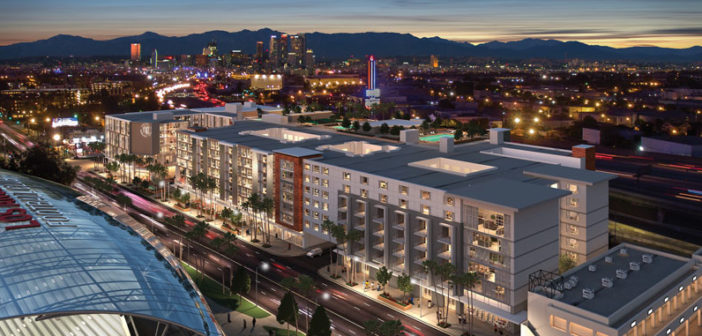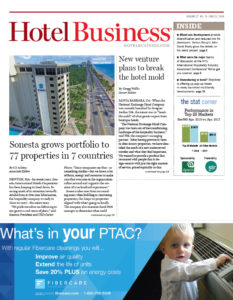LOS ANGELES—The Fig, an approximately $400-million, seven-story project set to break ground here later this year or early in 2019, is the latest in a number of mixed-use developments that aim to reduce investor risk by diversification.
“Through combining a mix of product types with varying risk profiles, investors receive the benefit of creating balance through diversifying their portfolio with a single development,” said John David Booty, EVP at Ventus Group, developer of The Fig. “This diversification can help sustain long-term success of both the portfolio and the individual project.”
The project will include a 298-key, dual-brand hotel, as well as a large residential component. It will feature 222 purpose-built, student-housing units, 104 market-rate multifamily units and 82 affordable units, to house a total of more than 930 residents. More than 74,000 sq. ft. of commercial space is planned, and is expected to include several destination retail and dining options, as well as creative office space.
The developer is already in talks with several major hotel brands for the project. “Due to a strong global economy, we are seeing a healthy travel and tourism industry that is contributing to the success of hospitality investments,” said Booty. “The Fig is ideally positioned to serve tourists, as it is located next to Exposition Park, a 160-acre destination currently undergoing approximately $2 billion in revitalization, including the construction of the recently opened Banc of California Stadium, the Lucas Museum of Narrative Art currently underway, as well as the expansion of the Los Angeles Convention Center and other major attractions.”
He continued, “That said, the industry can be volatile, with unpredictable factors having a potential strong impact. The assemblage of multiple components with diverse demand drivers can insulate the investment from some turmoil.”
The student housing component will serve the adjacent University of Southern California, which had 45,500 students enrolled this past academic year. “Student housing…tends to weather economic storms better than other asset classes due to steady demand by students who want to live within walking distance of their university,” he said. “Likewise, during turbulence, capital often flees to real-estate assets with stable cash flow, insulating well-located student housing from the full impact a severe downturn.”
The dual-branding of the hotel will also contribute to the diversification. “Diversification through dual-branding, including combining short-stay and extended-stay brands, or featuring both a higher-end brand with more amenities and a budget-friendly option at one site, is becoming increasingly attractive as it presents the potential for a much higher occupancy rate at a location,” said Booty. “Dual-branding appeals to a wider range of potential guests, which, in turn, reduces competition from nearby locations, helping investors to mitigate risk in both the short and long term.”
He continued, “Further, due to record-high (and rising) land prices, especially in areas where hospitality developments can be the most lucrative—such as urban infill sites—featuring two brands at one property can optimize returns on both land and construction cost investments. These locations also offer the potential to share lobbies, back-of-house areas and staff, and/or amenities, which can reduce operating costs as well.”
A major benefit of incorporating hospitality into mixed-use projects, rather than developing a hotel as a stand-alone property, is the synergy created through carefully selecting a location and complementary product types, according to Booty. “The hotel component can be instrumental in creating an all-encompassing, synergistic environment, through bringing in the guests that will take advantage of the shopping and restaurant options within walking distance, or as a convenient location for visiting families of students and other tenants of a residential component of a project.”
He continued, “The first critical strategy is to identify a quality location with built-in demand drivers for the multiple uses of a development. Ideally, these demand drivers work individually and together to contribute to the success of all components, creating an ecosystem where the different asset classes both drive and feed the demand of the others.”
Booty pointed to the student housing at The Fig as doing just that. “The hotel component sustains demand from visiting families of students, alumni and touring prospective students, in addition to tourists to the area,” he said.
There is an increased popularity of hotels incorporated into mixed-use developments near universities. “Examples include a 250-room, 250,000-sq.-ft. hotel and 23,000-sq.-ft. conference center development that will be located directly adjacent to the Texas A&M University campus, and a planned $3-billion, mixed-use development at San Diego State University including a hotel, retail, student housing and other product types,” Booty said.
For The Fig, hotel guests, tourists, residents and non-resident students will also provide a steady flow of retail consumers to feed that aspect of the development. “A balancing act is the key to success, even though it is not always easy to predict exactly which group will drive the majority of the demand,” he said. HB



